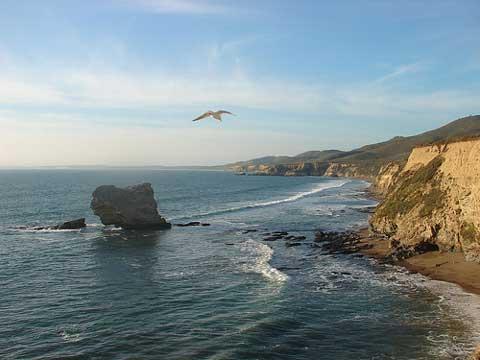If you're in the general vicinity of San Francisco during the next several months and are looking for an outdoor activity, Point Reyes National Seashore is a great spot to view elephant seals and migrating gray whales.
From December through March a breeding colony of elephant seals can be observed from Elephant Seal Overlook near Chimney Rock, above beautiful Drakes Bay. The males are the first to arrive here, in December, to stake out a claim on the beach. Then pregnant females begin to arrive and soon give birth to a single pup. Subadult and juvenile animals arrive and the colony can number close to one hundred animals.
From the Overlook you can witness the fascinating behavior of these animals, including male dominance contests, birthing of pups and the interactions of mothers and pups. You will hear the distinctive vocalizations of females, pups and the powerful trumpeting of the adult males (bulls) which can be heard for over a mile.
During weekends and holidays, highly trained docents staff the Overlook. They have binoculars, spotting scopes, and a wealth of information to share with you.
The headlands of Point Reyes also offer one of the best spots in the country to view gray whales during their annual migration between the waters of Alaska and Baja California. A park publication advises,
Here at Point Reyes National Seashore, the peak of the southern migration usually occurs in mid-January and that of the northern migration in mid-March. Late April and early May afford the opportunity to see mothers and calves close to shore. The areas around Chimney Rock and the Lighthouse offer some of the best whale watching spots in the park.
Several years ago, the combination of great wildlife viewing and outstanding coastal scenery simply became too much for the narrow roads and limited parking areas in the park, and traffic congestion was resulting in a less than ideal experience for many visitors.
Beginning in the mid-1990s, the park tried a number of different options to improve the situation, and the best solution has been the use of a shuttle bus system on weekends and holidays during the peak winter months. Here's the key information from the park about the shuttle:
The lighthouse shuttle bus system will begin on Saturday, December 26 and is scheduled to continue through mid-April. Sir Francis Drake Boulevard will be closed to private vehicles at the South Beach junction from 9:00 a.m. through 5:15 p.m. on Saturdays, Sundays and holidays when the weather is fair or better. To ensure the safety of bus operators and passengers, we do need to limit private vehicle access on the narrow and curving road while the buses are running.
Sir Francis Drake Boulevard from the South Beach junction to the Lighthouse visitor parking lot is open to private vehicles on weekdays, and on weekend days when the shuttle bus system is not operating.
You'll find a map of the area involved at this link.
Bus service is provided Saturdays, Sundays, and holidays from Drakes Beach directly to the lighthouse parking lot. Visitors can disembark for whale watching and viewing wildflowers, or they may continue on to Chimney Rock for hiking and seal watching. Visitors may also spend time at the Lighthouse and when ready return to the bus for the additional leg to Chimney Rock. Buses circle from Drakes Beach to the Lighthouse, Chimney Rock and back to Drakes Beach but do not return from Chimney Rock to the Lighthouse.
Tickets must be purchased at the Kenneth C. Patrick Visitor Center at Drakes Beach. No advance reservations are required. Ticket sales begin at 9:00 a.m. and bus service begins at 9:30 a.m. The charge is $5.00 per person (children 16 and under are free). Fee waivers are not available for recreational use user fees such as bus transportation. However, America the Beautiful Senior, America the Beautiful Access, Golden Age, and Golden Access passes may apply to these fees. Holders of these passes should request information at the time of purchasing bus tickets.
Buses run on demand throughout the day, and the average time between buses is 20 minutes. Tickets are sold until 3:00 p.m. with the last bus trip leaving Drakes Beach at 3:30 p.m. Sir Francis Drake Boulevard will remain closed until approximately 5:30 p.m. Shuttle service will not run during stormy or extremely wet weather. Check the telephone weather recording at (415) 464-5100, ext. 2 (then press 1) for updates on whether shuttles are operating.
You'll find additional details to help you plan a visit, including maps and driving directions to Point Reyes National Seashore, on the park website.




Add comment